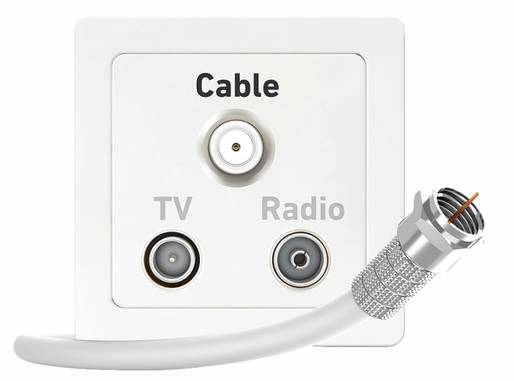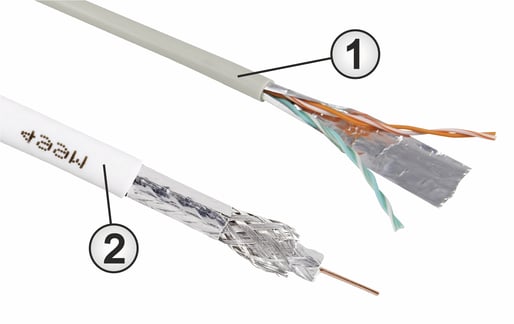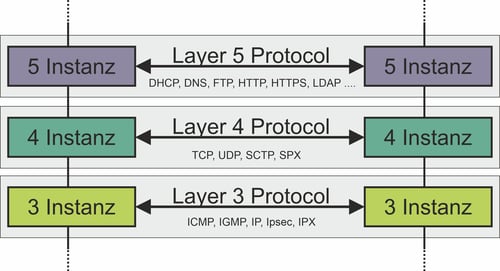DOCSIS standard » The key to fast Internet via cable TV
Published: 15.12.2022 | Reading time: 5 minutes
This text is machine translated.
The invention of the telephone in 1876 also marked the start of the development of a wired telephone network. Due to the increasingly rapid expansion of the network, it was not surprising that the existing telephone lines were simply used as the infrastructure for the first electronic data transmission in 1969. The Internet, which became available to the public in 1993, also required a telephone connection from the outset.
Even if the analog modems used at the time are now museum pieces, some of the current Internet connections still run over the thin telephone wires. However, there are now other ways to get fast access to the World Wide Web. One of these is cable TV and DOCSIS. In our guide, we explain what DOCSIS is and how it works.
The somewhat peculiar name DOCSIS is simply the string of initial letters for Data Over Cable Service Interface Specification. In principle, this is an interface specification for data transmission via cable. However, the specification does not describe transport via a telephone cable (1). Rather, it deals with the transmission of high data rates via a television cable (2), as used for a cable connection.
Similar to the expansion of the telephone network, a cable network for TV subscribers has also been built since the 1980s. Starting in the big cities, cable television became more and more widespread and was initially only designed as a distribution medium. In contrast to conventional two-wire telephone lines, far more information than just TV signals or radio programs can be transmitted via shielded coaxial lines.
And by using headends with return channel capability, it is now also possible to transmit signals in both directions on the TV cable. However, the fast, secure and efficient transmission of data in a broadband cable network requires a certain standard, which was created in 1997 with the DOCSIS standard.
In order to explain how the DOCSIS standard works, we first need to take a brief look at the OSI (Open Systems Interconnection) layer model. This is because the DOCSIS specifications are located on layers one and two in the OSI model. Depending on the DOCSIS version, this includes transmission bandwidths, multi-carrier modulation methods and multiplexing methods. The OSI model is an architecture structured in seven layers or levels, which describes the regulated communication of different technical systems within a computer network.
The layers build on each other starting with the first layer, whereby the respective instances, i.e. the organizational units in a hierarchical command structure, provide their services to the layer directly above.
The seven layers of the OSI model:
| Layer | OSI-Layer | Function | Classification |
|---|---|---|---|
| 7 | Application Layer | Application | Application-oriented |
| 6 | Presentation Layer | Application | Application-oriented |
| 5 | Session Layer | Application | Application-oriented |
| 4 | Transport Layer | Transportation | Transportation-oriented |
| 3 | Network-Layer | Internet | Transportation-oriented |
| 2 | Data Link Layer | Network access | Transportation-oriented |
| 1 | Physical Layer | Network access | Transportation-oriented |
Data transmission within the shift model
Even if the individual layers build on each other vertically, direct data transfer takes place horizontally between the instances of the respective layers.
Different protocols are used in each layer for this purpose.
Three of the seven layers are shown as examples in the attached illustration.
Since its introduction, the DOCSIS protocol has undergone continuous further development. This has enabled the DOCSIS standard to be adapted to the technical conditions, such as changed frequency ranges, the introduction of fiber optic technology and also to the constantly growing demands on transmission speed. The original frequency range was between 50 MHz and 862 MHz when it was introduced. In the meantime, the frequency range has been extended to 1,800 MHz or 1.8 GHz, whereby the frequencies of the discontinued analog TV channels are also used for data traffic.
DOCSIS 1.0
With the standard specified by an American cable network operator in 1997, data transmission speeds of around 40 Mbit/s downstream and 10 Mbit/s upstream were already achievable.
DOCSIS 2.0
With DOCSIS 2.0, which appeared in 2002, the bandwidth per subscriber was increased so that real-time transmissions were possible. The upstream speed was increased to 30 Mbit/s.
DOCSIS 3.0
From 2006, DOCSIS 3.0 made it possible to bundle up to 32 transmit and receive channels. This increased the downstream speed to 1 Gbit/s and upstream speeds of up to 100 Mbit/s were now possible.
DOCSIS 3.1
Thanks to an improved modulation process and the flexible use of carriers of different widths, speeds of 10 Gbit/s for download and 1 Gbit/s for upstream are supported. By switching off the analog TV channels, the usable frequency spectrum now ranges from 5 MHz to 1.8 GHz.
DOCSIS 4.0
The DOCSIS 4.0 standard is a further development of the DOCSIS 3.1 full-duplex version released in 2017. The supported downstream speed of 10 Gbit/s has been retained, but the upstream speed has been increased to 6 Gbit/s. The latency time required by a data packet from the end device to the server and back again has been reduced to 1 ms.
Note EuroDOCSIS 3.0
The PAL (Phase Alternating Line) TV standard used in Europe has a channel raster of 8 MHz. In contrast, the bandwidth of the NTSC system used in America is only 6 MHz. As a result, the DOCSIS specifications were adapted for Europe and designated EuroDOCSIS. From version 3.1, there is no longer a distinction between DOCSIS and EuroDOCSIS 3.0.
In order to be able to use high-speed Internet access via cable TV, it is necessary to check in advance whether a house transfer point (HÜP) for cable TV is available. As the cable network was initially expanded in the larger metropolitan areas, availability varies greatly from region to region. If necessary, the local cable provider should be contacted to clarify whether a connection can be installed.
From the house transfer point, the signals are first amplified and distributed individually throughout the building. The respective signals for TV, radio and data transmission are distributed via multimedia sockets. The “cable” connection of the multimedia socket is then connected to a cable router with an integrated modem. Like a classic DSL router, this modem or cable modem performs all common tasks such as LAN, WLAN and telephony.
As the TV cable network is a shared medium, the cable modems of the connected subscribers must share the available bandwidth. And yet an Internet connection via cable TV is significantly faster and more stable than Internet access via DSL. The DOCSIS standard defines a MAC layer (Media Access Control), which network operators can use to set bandwidths, configure services and also maintain modems. To prevent unauthorized “reading” of external data rates, data traffic between the head-end station and the respective cable modem is encrypted.
DOCSIS-compatible products
This question is ultimately only of interest to people who have both a telephone connection and a cable TV connection. We have summarized the most striking differences in the following table.
| Connection type | Telephone cable | Cable TV |
|---|---|---|
| Download transfer rates | 16 Mbit/s (DSL) 100 Mbit/s (VDSL) 250 Mbit/s (Supervectoring) | Up to 10 Gbit/s |
| Upload transfer rates | 40 Mbit/s | Up to 6 Gbit/s |
| Availability | Comprehensive expansion | No nationwide expansion |
| Provider | Wide range of providers and extensive offers | Reduced supplier diversity |
| Advantages | High availability Constant speed Every user has their own line | Very high downstream rates Stable signals thanks to the use of amplifiers |
| Disadvantages | Unstable at long distances from the distributor Slower downstream data rates | Speed fluctuations during peak times No comprehensive availability |
Conclusion:
Due to the higher data rates, cable Internet definitely has clear advantages for IP telephony, livestream conferences and the fast exchange of large amounts of data. This is also the reason why companies and businesses prefer this type of connection. Provided a cable connection is available. And with the increasing expansion of the gigabit cable network via fiber optics, even faster Internet connections will be possible in the future.


